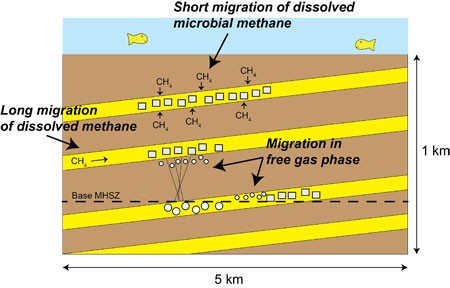Methane migration and massive hydrate deposits
in marine sediments
By:
Hugh Daigle
UT Department of Petroleum and Geosystems Engineering
| When: | Friday, April 4, 2014, 10:30 a.m. to 11:30 a.m. Join us for coffee beginning at 10:00 a.m. |
| Where: | Seminar Conference Room, 10100 Burnet Road, Bldg 196-ROC, Austin, Texas 78758 |
| Host: | Sean Gulick, UTIG |
Click for a Live Broadcast.

Abstract
Massive hydrate deposits, defined as thick accumulations of high hydrate saturation, have been encountered in many regions worldwide. As hydrates begin to be exploited as an energy resource, it is becoming more important to understand the mechanisms that lead to development of massive hydrate deposits in coarse-grained sediments, which are the most attractive reservoirs for exploration and production activities.
Hydrates may be thought of broadly within a petroleum systems framework, requiring a methane source, migration mechanisms, a reservoir, and an appropriate seal. Hydrate reservoirs and seals are defined by thermodynamics rather than buoyancy, as in the case of conventional oil and gas. Hydrates form most easily within coarse-grained sediments within the methane hydrate stability zone (MHSZ), the depth interval in which pressure and temperature favor hydrate as the stable phase.
Migration of methane into the MHSZ may occur in the dissolved phase or as a free gas phase. The methane flux and the phase of supplied methane determine the rate of hydrate formation, the amount of hydrate formed, and its distribution. The evolution and persistence of massive hydrate deposits therefore require a sufficient methane supply.
Three migration mechanisms are possible: (A) diffusive flux within the MHSZ of dissolved methane from finer-grained units into coarser-grained units where hydrate forms preferentially, known as short migration; (B) advective flux of dissolved methane from a source at depth into the MHSZ, known as long migration; or (C) migration of methane in the free gas phase, either produced locally within the MHSZ or supplied from the base of the MHSZ from long migration or from recycling of hydrate that is buried beneath the base of the MHSZ.
Current research is focusing on these migration mechanisms in marine hydrate reservoirs as they represent some of the least understood processes in hydrate systems, but at the same time represent a crucial link between sites of methane generation and hydrate reservoirs.




